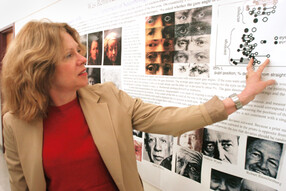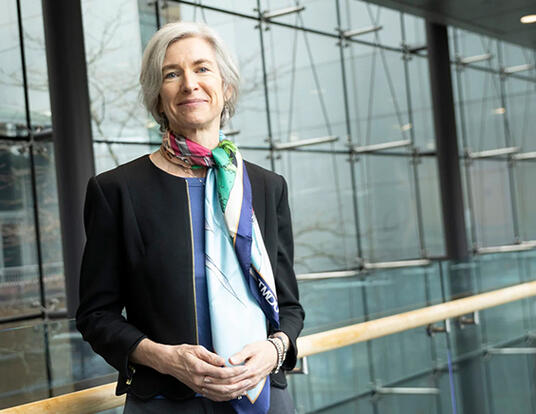Fertile Ground
Humanists are turning to cognitive and neuroscientists — and vice versa — to gain new insights into perception and experience.
If you’ve ever seen Claude Monet’s Impression, Sunrise, an 1873 painting of a misty harbor at dawn, you may have noticed that the red-orange sun glowing in the sky seems to pulsate amid the surrounding gray clouds. This jittery effect is not just a trick of the imagination; it’s actually a neuroscientifically measurable byproduct of the disconnected nature of visual processing in the brain.
While brain regions that respond to color detect the boundary between Monet’s sun and clouds, other parts of the brain that process light intensity do not, because these shapes reflect the same amount of light. In a black-and- white version of the piece, the sun would vanish. Because of the lack of luminance information, which normally helps us pinpoint items, the sun appears to move around, and the work of art comes to life.
This technique, called equiluminance, has frequently been used by Impressionists and pointillists to make their paintings sparkle. But working artists are not alone in their explorations of how our brains shape our perceptions. Scholars from fields as seemingly disparate as art and neuroscience, or psychology and literature, are increasingly recognizing how their knowledge can mutually enlighten one another, and they are acting to break down longstanding barriers between the humanities and cognitive science.
The Art of Seeing

Having taken personal inspiration from art for decades, Margaret Livingstone, a professor of neurobiology at Harvard Medical School who works with PhD students in neuroscience, regularly includes art slides in her presentations to illustrate how vision works.
Early on, Livingstone didn’t know much about art history, so she decided to brush up on the topic. While reading an art book in her office in 2000, she came across a picture of Leonardo da Vinci’s Mona Lisa and pondered a question that has teased admirers of this masterpiece for centuries: Why is Mona Lisa’s smile so elusive? “I looked at it as if I had never seen it before and noticed that the effect had something to do with where I was looking,” Livingstone says. When she stared at Mona Lisa’s mouth, its outline was sharp and clear, but when she gazed at the background, the lips appeared blurry.
As she was riding her bicycle one crisp fall day, she was struck by an idea: Perhaps the smile’s ambiguity is caused by differences in spatial acuity between the center of gaze and the peripheral visual field. To simulate what the smile would look like to central and peripheral vision, Livingstone filtered the image to exaggerate either coarse shapes or fine features, such as lines and edges. She found that the blurry mouth seems more cheerful than the sharp one, and so the strength of Mona Lisa’s smile depends on where the viewer looks.
A few years after logging this discovery, Livingstone traveled to Paris to find out whether equiluminance could explain the shimmering quality of the sun in Impression, Sunrise. During a trip to the Louvre Museum, she entered a room full of Rembrandt self-portraits and noticed that the painter’s eyes did not align properly, suggesting that he had trouble perceiving depth. This casual observation stimulated an experimentally testable question: Is poor depth perception linked to artistic ability? “Some artists are so talented that you have to consider the possibility that there’s something about their brain that makes them better at art,” she explains.
Upon returning to the US, Livingstone piled dozens of Rembrandt self-portraits on her desk and measured his eye alignment, confirming her hunch. She later found that established artists are more likely to have deviating eyes than the general population. Artists often close one eye to more easily portray three-dimensional scenes on flat surfaces using pictorial depth cues, such as perspective, occlusion, and shading. “If somebody already sees the world as slightly flatter, they have a built-in advantage when they’re kids that might make them tend toward wanting to become an artist from the get-go,” Livingstone says.
Left Brain, Meet Right Brain

Inspired by conversations with colleagues in Cambridge, Stephen Kosslyn, Harvard’s former dean of social science and John Lindsley Professor of Psychology — and an expert on mental imagery — organized a two-week summer workshop in July 2011 that explored intersections between the humanities and cognitive sciences at Stanford University’s Center for Advanced Study in the Behavioral Sciences (CASBS). Advanced graduate students and young investigators were admitted from a variety of humanistic fields, from film studies to philosophy, to explore fundamental principles of cognitive science and neuroscience and relate them to work in the humanities. “The ultimate goal is to enrich both the humanities and the sciences,” says Kosslyn, who now directs CASBS.
Participants surveyed a range of topics, from perception and imagery to motivation and morality, and focus on such interdisciplinary questions as why audiences empathize with certain movie characters and how different types of music elicit distinct emotions. “If you know basic facts about how the mind works, you can begin to understand why some pieces of art, music, and literature are more successful than others,” Kosslyn says. “I don’t think there’s going to be any shortage of possible connections between various aspects of the humanities and cognitive science and neuroscience.”
Forging these connections has become easier in recent years, says Anne Harrington, who was a co-director of the summer work- shop at Stanford and a professor of the history of science at Harvard. “Neuroscience and the cognitive sciences have themselves become more expansive and interested in things that speak to intrinsic concerns of the humanities,” she says. “That makes the perceived potential for dialogue much more attractive and potentially much more constructive for a lot of people than it might have felt a generation or two ago.”
Dialogue between areas of study — engaging topics like information processing, memory, aesthetics, emotions, the unconscious, and ethics — is essential for a strong university, adds Harrington, whose most recent book is The Cure Within: A History of Mind-Body Medicine. “In the end we’re one academy, and over the long term the academy can’t be as robust and can’t flourish if we set up these silos in which we burrow down and do our own work without asking about what our colleagues in the next building might know about the same phenomenon,” she says. “The most important thing going forward has to be to try to create a community in which the genuinely important insights and methods of people in both camps can be understood and respected.”
The Literary Brain
By describing the way dappled light streams through a window and falls onto a chair, or the way a man and a woman circle around one another on a dance floor, writers can evoke mental images that are almost as vivid as objects we see in front of us, creating rich sensory worlds out of nothing but black marks on a page.
As literary theorists are coming to appreciate, the effectiveness of these writerly techniques can be explored not only through the narrative itself, but through experimental research in fields such as psychology. “A lot of great thinking about the mind goes on across the University, within different disciplines,” says Elaine Scarry, the Walter M. Cabot Professor of Aesthetics and General Theory of Value, who considered questions of how literature produces rich interior imagery in her 1999 work, Dreaming by the Book. “There’s more and more good will toward the idea of working across disciplines” — taking research and new modes of thinking out of the silos that limit their impact.
To encourage interaction among humanists and scientists, Scarry cofounded the monthly Seminar in Cognitive Theory and the Arts in 2000, with Alan Richardson, PhD ’85, a professor of English at Boston College who published The Neural Sublime: Cognitive Theories and Romantic Texts in 2010. The seminar, held at Harvard’s Mahindra Humanities Center, is still going strong, attracting faculty and graduate students from neuroscience, literature, music, philosophy, and art history.
Joshua Rothman, a PhD student in the English Department, is a regular attendee who gave a talk last fall about 19th- and 20th-century novelists’ descriptions of the varying timescales of conscious experiences, from a single day to a lifetime. “Novel writing was the real psychology before there was experimental psychology,” he says. “Reading literature tells you a lot about people — how they behave, what they’re made of, and how to think about them.”
People read fiction because they enjoy thinking about the intentions of others, says Anna Henchman, PhD ’04, an assistant professor of English at Boston University who is one of the directors of the seminar. “We can learn a lot about our mental abilities from studying texts, which are much more complex than a lot of psychological experiments.”
To understand these elaborate psychological scenarios, more literary scholars are turning to cognitive theory, including Henchman herself. For her new book, she is applying what she has learned in the seminar about theory of mind — the ability to attribute knowledge, intentions, and feelings to others — to crawl into the heads of tiny creatures, such as worms and ants, as they burrow into the ground or walk along a blade of grass. “There’s not one objective perceptual world that we as humans have access to,” she says. “We all have certain perceptual organs and certain things that we try to pay attention to in the world, and the world is constructed by those perceptual organs.”
At the same time, neuroscientists are asking questions that pertain to literary studies. For example, seminar participant Joshua Greene, an assistant professor of psychology, has used neuroimaging to examine the influence of emotions and reasoning on moral judgments, and Daniel Schacter, the William R. Kenan, Jr. Professor of Psychology, has used the same method to investigate the relationship between remembering the past and imagining the future.
“Moral conundrums are constantly explored in the arena of fiction, and acts of prediction and forecasting are at the center of what a reader does in moving through a narrative,” Henchman says. “By the end of the story, there are all these possibilities and shadow plots that have already been imagined by the reader.”
Many Minds Together
Harvard’s Mind/Brain/Behavior Interfaculty Initiative (MBB) has brought together faculty and students from many disciplines since 1993, when then-President Neil Rudenstine called for programs that would unite scholars in the brain and mind sciences across Harvard’s schools. Co-directed by Alfonso Caramazza, a professor of psychology at FAS, and Albert Galaburda, a professor of neurology at Harvard Medical School, the MBB provides courses, seminars, lectures, and research awards and builds community for undergraduate and graduate students, postdoctoral fellows, and faculty who are examining the nature of the mind using a variety of approaches, such as behavioral testing, electrophysiology, computer modeling, biochemical techniques, genetics, neuroimaging, and philosophy.
The MBB has long offered track programs and secondary fields to undergraduates, but starting this fall, a secondary field in MBB will be offered to graduate students, who “oftentimes provide the connective tissue between faculty members in different departments,” Galaburda says.
PhD students in the core MBB disciplines will be able to follow a specialized secondary field, while a general track will be offered to other graduate students. A steering committee composed of eight graduate students has led to alliances with related graduate-student groups, such as the Student Association for Law and Mind Sciences at Harvard Law School, in addition to symposia and a seminar series that have explored topics including the history of violence, moral cognition and the law, the usefulness of emotion for computer science, and complex decision making and the brain.
Get the Latest Updates
Join Our Newsletter
Subscribe to Colloquy Podcast
Simplecast Stitcher




